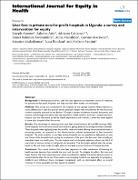| dc.contributor.author | Amone, Joseph | |
| dc.contributor.author | Asio, Salome | |
| dc.contributor.author | Cattaneo, Adriano | |
| dc.contributor.author | Kweyatulira, Annet Kakinda | |
| dc.contributor.author | Macaluso, Anna | |
| dc.contributor.author | Maciocco, Gavino | |
| dc.contributor.author | Mukokoma, Maurice | |
| dc.contributor.author | Ronfani, Luca | |
| dc.contributor.author | Santini, Stefano | |
| dc.date.accessioned | 2018-07-26T10:37:38Z | |
| dc.date.available | 2018-07-26T10:37:38Z | |
| dc.date.issued | 2005 | |
| dc.identifier.citation | Amone, J., Asio, S., Cattaneo, A., Kweyatulira, A.K., Macaluso, A., Maciocco, G., Mukokoma, M., Ronfani, L. and Santini, S., 2005. User fees in private non-for-profit hospitals in Uganda: a survey and intervention for equity. International Journal for Equity in Health, 4(1), p.6. | en_US |
| dc.identifier.uri | http://hdl.handle.net/20.500.12280/558 | |
| dc.description.abstract | Background: In developing countries, user fees may represent an important source of revenues
for private-non-for-profit hospitals, but they may also affect access, use and equity.
Methods: This survey was conducted in ten hospitals of the Uganda Catholic Medical Bureau to
assess differences in user fees policies and to propose changes that would better fit with the social
concern explicitly pursued by the Bureau. Through a review of relevant hospital documents and
reports, and through interviews with key informants, health workers and users, hospital and nonhospital
cost was calculated, as well as overall expenditure and revenues. Lower fees were applied
in some pilot hospitals after the survey.
Results: The percentage of revenues from user fees varied between 6% and 89% (average 40%).
Some hospitals were more successful than others in getting external aid and government subsidies.
These hospitals were applying lower fees and flat rates, and were offering free essential services to
encourage access, as opposed to the fee-for-service policies implemented in less successful
hospitals. The wide variation in user fees among hospitals was not justified by differences in case
mix. None of the hospitals had a policy for exemption of the poor; the few users that actually got
exempted were not really poor. To pay hospital and non-hospital expenses, about one third of
users had to borrow money or sell goods and property. The fee system applied after the survey,
based on flat and lower rates, brought about an increase in access and use of hospital services.
Conclusion: Our results confirm that user fees represent an unfair mechanism of financing for
health services because they exclude the poor and the sick. To mitigate this effect, flat rates and
lower fees for the most vulnerable users were introduced to replace the fee-for-service system in
some hospitals after the survey. The results are encouraging: hospital use, especially for pregnancy,
childbirth and childhood illness, increased immediately, with no detrimental effect on overall
revenues. A more equitable user fees system is possible. | en_US |
| dc.language.iso | en | en_US |
| dc.publisher | BioMed Central Ltd. | en_US |
| dc.subject | User fees in private non-for-profit hospitals in Uganda | en_US |
| dc.title | User fees in private non-for-profit hospitals in Uganda: a survey and intervention for equity | en_US |
| dc.type | Article | en_US |


